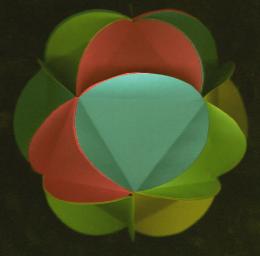Skip over navigation

Or search by topic
Number and algebra
Geometry and measure
Probability and statistics
Working mathematically
Advanced mathematics
For younger learners
Making Maths: Triangular Ball
Age 7 to 11
Challenge Level 






You will need:
- Four or five sheets of stiff paper or thin card
- Scissors
- Pencil
- Glue or stapler
What to do:
- Cut out 20 circles, all the same. (Make it easy for yourself - cut through two or three sheets of paper at the same time.)
- Fold three flaps in to make an equilateral triangle.
To do this, first find the centre of the circle by folding it in half, then half again. Now fold one edge in to touch the centre. Fold another flap in to touch the centre AND make a point. Now fold the last flap in to the centre.

- Use this triangle to mark triangles on all the other circles and fold over all the flaps.
- Join (with paste or a staple) the flaps of five of the circles to make the top of the ball - like this:
When you join the last flaps it will pull up into a sort of pyramid shape. Keep the flaps on the OUTSIDE.

- Join another five circles in the same way to make the bottom of the ball.
- Join the ten circles that are left in one long strip.

- Bend the strip around and join the end flaps - keep the flaps on the outside.
- Now join the top and bottom on to this strip - there's the ball!

